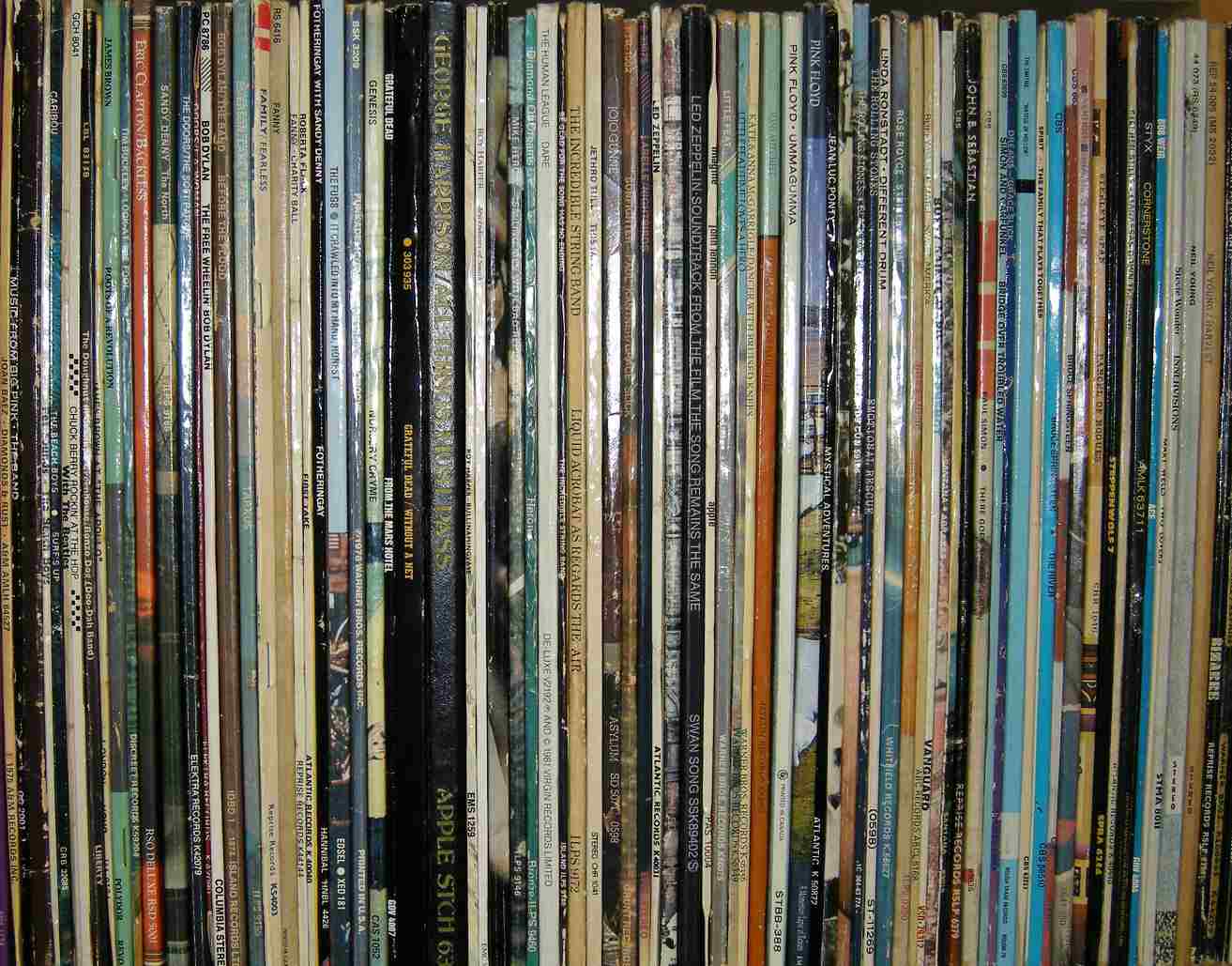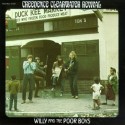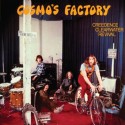Creedence Clearwater Revival
| Track | Album |
|---|---|
| Born On The Bayou | Bayou Country |
| Fortunate Son | Willy and The Poor Boys |
| Have You Ever Seen The Rain? | Pendulum |
| I Put A Spell On You | Creedence Clearwater Revival |
| It Came Out Of the Sky | Willy and The Poor Boys |
| Lodi | Green River |
| Long As I Can See The Light | Cosmo's Factory |
| Proud Mary | Bayou Country |
| Ramble Tamble | Cosmo's Factory |
| Travelin' Band | Cosmo's Factory |
Contributor: Rob Millis
Ask a member of the public what they remember about Creedence Clearwater Revival and it’ll be the “Rooollling …” choruses of Proud Mary or their no-nonsense rock radio cover of Suzie Q. Ask a musician what they remember about them, and after a misting over of the eyes, a half whispered, reverential “great amp tremolo” will issue forth.
Neither is wrong; the punter remembers the band that laughed in the face of psychedelia and delivered foot-stomping rock and roll hit after foot-stomping rock and roll hit. The great voice and songs of John Fogerty. The “Fantasy” record label so alien to non-jazz fans.
The musician remembers the great days of the late sixties when a decent guitar amp really was a thing of beauty. Sure – their main job was to give volume; a facet dating back to days of poor old Charlie Christian trying to cut through all those poxy horn players and give us modern electric guitar as we know it. But by the sixties, they had other benefits. Spring reverb – an invention (along with the electro-mechanical organ, 3-D glasses, automatic car transmission and the green baize bedecked auto-shuffling/dealing card table) of one Laurens Hammond, that ran an audio signal across long springs hanging in a steel tray to give faux echo effects. But really nice amps had tremolo or vibrato effects as well – modulation of (respectively) the volume or the pitch of what was being played. And it shimmered, animated the sound and was – and is – ear candy for the discerning.
There is no better example of it than the swampy (an oft-used term in discussion of such sounds) opening notes of Born On The Bayou. How it shimmers – nay, dances – into focus and then comes the rhythm section and that huge voice. If it wasn’t for Leo Fender, so much in our lives would be that much more “vanilla”.
But there – we jump ahead. Let’s start with I Put A Spell On You from their first eponymous platter which belies the back-to-basics approach of CCR albeit briefly. Quasi psych production and treated guitar sounds abound, but a huge vocal as ever. Released in 1968, the band broke through very quickly with both this track and Suzie Q (first top 40) success hitting home.
Bayou Country followed in March 1969; from that platinum seller we’ll have the aforementioned amp tremolo of Born On The Bayou and – much as I’d like Keep On Chooglin’, Peter Viney would strangle me if I didn’t cave in and offer Proud Mary. And why not – like so many songs that universal (Mustang Sally is an exceptionally good example) we cannot let the flood of sub-par renditions ruin the majesty of the original, and our enjoyment of it. Nor should Ike & Tina Turner’s version of it be included in that category. Let’s also not forget Bootleg – in the UK at least, I’m sure a few out there will remember it on the old Liberty Records Son of Gutbucket sampler LP, with affection.
Well, I caved in on Proud Mary, but I will stand firm and take Lodi (rather than Bad Moon Rising) from Green River, the third LP and released just five months after Bayou Country. I read somewhere that Lodi is the most common “small town” name in the USA apart from Springfield – maybe a Stateside reader would confirm or deny this?
The five-month gap between albums was reduced to a staggering three with the release of Willy and the Poor Boys in November 1969. Of all the fantastic CCR singles, and even by their own standards, the driving and unrelenting Fortunate Son is my favourite by a country mile. We could have Down On The Corner as well, but I’m not giving up It Came Out Of The Sky. At first glance a simple rock and roller, but such a lovely story in the lyrics. With Reagan gone, “… and Ronnie the popular said it was a Communist plot” takes you back. I’ve literally just finished listening to it now, and had forgotten the lovely harmonies of Cotton Fields that follow.
CCR hit 1970 with a bang: the previous year had produced three chart albums and a fistful of hits, and January of 1970 showed no signs of resting on their laurels as the double A-side of Travelin’ Band/Who’ll Stop The Rain leapt up the charts to number 2 at home. I’m not surprised – just how it is possible to spit out all those words and retain the power and passion is way beyond me.
1970 was a year of major touring – including their first jaunt to Europe – and by their standards it was a long wait until July for Cosmo’s Factory, with the previous two tracks on it as well as all manner of CCR chestnuts. I’ll mention Up Around The Bend as another hit, but will take Travelin’ Band and two very different album cuts. Ramble Tamble opened the album with a two-pronged attack of “Mystery Train” type rockabilly and then opening out into vistas of open landscape by way of some very late sixties arpeggiated guitar parts. Sun Records-meets-Abbey Road is what I always call that track. Having had the opener we’ll also have the gorgeous electric piano-led ballad of Long As I Can See the Light.
Then it all gets a bit weird, and it does seem to this observer to be John Fogerty’s fault. Long the dominant writer and lead singer – and to be fair, they’d done bloody well out of his talents – his tight control first saw off elder brother and rhythm guitarist Tom during the recording of Pendulum in late 1970 (from which we’ll take Have You Ever Seen The Rain? to top off the ten tracks).
Then it all gets even weirder, and again it seems to be John Fogerty’s fault. Having seen off his brother due to his tight grip on the reins, Fogerty changed course 180˚ and informed Doug Clifford (drums) and Stu Cook (bass) that CCR would be a democratic co-operative going forward, so they’d better come up with some material and be prepared to sing it. Success was ongoing – a high-grossing tour of Europe in 1971 yielded an LP but the band were at loggerheads and Mardi Gras limped out in 1972 to unflattering reviews. I’ve not bothered with it here, but I think the truth is similar to that of The Band’s Cahoots LP – it followed some far more impressive work, but if it had sported the name of a different artist it would have been raved about. And that was that. Clifford and Cook would both end up working for Doug Sahm, with Clifford in the Sir Douglas Quintet at the very end of it. Tom Fogerty reappeared in the Jerry Garcia/Merl Saunders “Keystone” band in 1973 and delivered a solo album in 1974 marking the last time the original quartet of CCR would be heard together on record. Tom Fogerty died in 1980 after complications from back surgery.
John Fogerty endured a long legal battle over contractual obligations (Google it; it’s too long winded to go into here) and some bad advice regarding band income. His hit, The Old Man Down The Road, in 1985 was a return to form, although even that was plagued with legal issues after former manager Saul Zaentz (owner of the CCR catalogue after Fogerty parted with it to help extricate himself from the old contracts) spotted Fogerty had rewritten Run Through The Jungle and sued for self-plagiarism! Fogerty for years vowed he would not perform CCR songs while Zaentz owned the rights to them, but eventually in the last twenty years or so he has relaxed this policy, delighting audiences once again with those old hits, standing triumphantly in front of his old Kustom amplifiers with their distinctive padded cabinets.
And that tremolo effect…
Creedence Clearwater Revival Wikipedia
Creedence Clearwater Revisited
Creedence Clearwater Revival official facebook
Creedence Clearwater Revival biography (Apple Music)
Rob Millis has provided Hammond organ, Wurlitzer electric piano and vocals for such names as Dave Kelly, Micky Moody, John Fiddler. Rob resides in the borough of Richmond-upon-Thames, where (as we all know) the blues was first invented …
TopperPost #149






Great list and write-up. As a singer and songwriter John Fogerty may deserve more credit than he gets. I saw him live a couple of years ago, and his voice is still in great shape (though the live versions were a bit too close to the recorded album versions for my taste). Fortunate Son is my favourite too, but I’d also try to find a way to include Someday Never Comes and (Wish I Could) Hideaway.
Excellent piece, Rob, but I’m going to grumble and lobby for the inclusion of Bad Moon Rising, Down On The Corner and Who’ll Stop The Rain? And really I’d like Up Around The Bend too. I’d knock out I Put A Spell On You, because basically CCR did originals so neat and so strong that they didn’t need to do covers (hence no call from me for Suzie Q, Before You Accuse Me, Midnight Special, Ooby Dooby, I Heard It Through The Grapevine). In essence, they epitomise the “singles band” and thrill me at the sub-3 minute mark, but I don’t want to hear them choogle through seven minutes or 11 minutes. OK, they can have an extra 31 seconds when the song is as great as Long As I Can See The Night, but no more. I recall them in 1970, seen so much as a “singles” band that they seemed a guilty pleasure next to the usual West Coast suspects. Fogerty is too good a songwriter to replace his songs with covers, though not so prolific that they didn’t need them. Perhaps it was a case of too many albums in too short a time? Ramble Tamble didn’t play in my head and I had to pick up the CD to hear it, “Ah, the opening track I always skipped on Cosmo’s Factory.” John Fogerty did Glastonbury in 2007 (I was about to write “last year” but I checked). The whole show is on YouTube, and begins with Who’ll Stop The Rain. Great keys on that show, but I remember watching it on TV and getting really annoyed by the big stereo drums. CCR needed simpler, straighter work on the kit.
Peter, I used to have a posh record deck that involved taking the platter off and rethreading the drive belt to play 45s, which is why singles went off my radar very early on in my vinyl collecting years and because of my age, I was generally buying stuff that wasn’t current so it wouldn’t be until I really got into a band and read up that I’d even know what the singles were necessarily; I’d think in album sides.
You could name any CCR single and love it but I’ll defend my position on Lodi and It Came Out Of The Sky as favourites. The latter is such a quirky bit of storytelling and the former is just a lovely melodic song, far more rewarding to my ears than Bad Moon Rising which (puts on tin hat and ducks under the table) I’ve never thought was as good as most of Fogerty’s singles choices fore and aft.
Great essay. While we all can shake up the list, adding and deleting various songs for another, I am most pleased at the inclusion of Ramble Tamble to the list. It shows CCR as something that they are generally not regarded as: a “jam band” and a damn good one at that. Probably my personal favourites are the longer, stretched out ones like Ramble Tamble, Suzie Q, Heard It Through The Grapevine.
Thanks Alex, I agree on Ramble Tamble as a fine piece of work to showcase the fact that CCR weren’t just the three chord strumalong band everybody thinks they were. By a long chalk too – folk too easily see the hit tally of the band and assume they couldn’t play as well as a more improvisational band at the time and that just isn’t true at all.
I love “Lodi” too, but I’ve just realized I want “Green River” too. I still have a turntable where you have to lift the platter for 45s … I think they’re mainly like that now. We’ll have to do a session on why 45s can sound better than LPs!
Let me expand on jamming and choogling along. CCR had a superb, clear rhythm section and they could jam extremely well and did play elongated pieces of classic songs. I should preface by saying I spend my days working on a book on 45s which means I always look at the singles. In 1970, I was working with music and often saw four or five two and three band gigs in a week. So many, many bands could play Midnight Special, or Johnny B. Goode or a soul standard and jam cheerfully and well for ten minutes. As indeed could CCR, though CCR had a “feel” that most couldn’t match. But CCR could do those tight, great singles which most of the other bands simply couldn’t do as well in their wildest dreams. I played CCR singles a lot in their day as an antidote to LPs and live jams. I know all their LPs interspersed them with longer work outs, so I fully accept that they could play well as an improvisational band. But CCR’s “USP” (unique sales pitch) was the singles.
Peter, we have each explained in turn that we tend to think in either album or singles terms with CCR when getting what we want out of them. There is a danger of both of us simply justifying our own viewpoint here rather than any helpful CCR talk, as the newcomer isn’t going to be buying the new 7″ from Creedence next Monday any more than the album buyer is going into a record store for a vinyl LP to check the band out on. I do agree on the singles element of CCR being “so out of fashion it felt new” but I think that your main brilliant point is the FEEL of CCR. There’s a lazy comparison that you will know well: Americana hit big in 1969 and you had CCR for singles and The Band for albums. I don’t agree with that ideologically but in cold sales analysis it probably holds water. I think a truerism (try that one for me at the Oxford E D can you!) is that both bands ditched psych and got back to basic songs that told a story. The difference is actually that CCR would nail an arrangement of the story to suit their swampy sound, whereas The Band would have countless little internal variations of line-up to enable the opposite discipline: where the band would bend their instrumentation to fit the story.
John Fogerty, Robbie Robertson and Jackson Browne appear to have one thing in common now … Dawes.
Nice to know that somebody is carrying on the tradition of Jesse Ed Davis, Russ Kunkel and Joe Lala!
What about album covers? One of the most memorable covers ever is Willie And The Poor Boys album with its swinging blue and gray humidity. One of the most awful covers is Cosmo’s Factory album with its ‘Lost and found auction’ feeling.
Are you kidding about Cosmos? Maybe it’s just me that likes to look at Fender amps a lot!
I’m fond of a Fender photo myself, Rob. But do I want to look at a bearded bloke on a bike in front of blue curtains? I think Cosmo’s Factory is an awful sleeve, including the lettering. I agree, Willie and The poor boys is aesthetically pleasing as sleeve design. But CCR are not a notable sleeves band, Some bands, especially British bands, are – the art school dance goes on forever – and some haven’t a clue.
Yes Peter, British bands can have terrific sleeves. John Mayall’s jugend style sleeves on Bare Wires and Blues From Laurel Canyon are masterpieces. Where are British blues bands in this site?
Picked up CCRs greatest hits of which most of these are on. And all killer, no filler. Perhaps the most underrated band… Down on the corner (my wot no!?) is almost dumb. But it isn’t. The anger of fortunate son (whose lyrics are still true today … Change millionaires son to billionaire’s son and ‘hail to the chief’ to advance Australia fair and it’s Australia today. Looking out my back door could be 70 years old. Or written yesterday.
I agree, David. I had CCR Greatest Hits in my car CD player, but not any more. It took too much of concentration from the road . Too much bass playing with the manual gear shift, too.